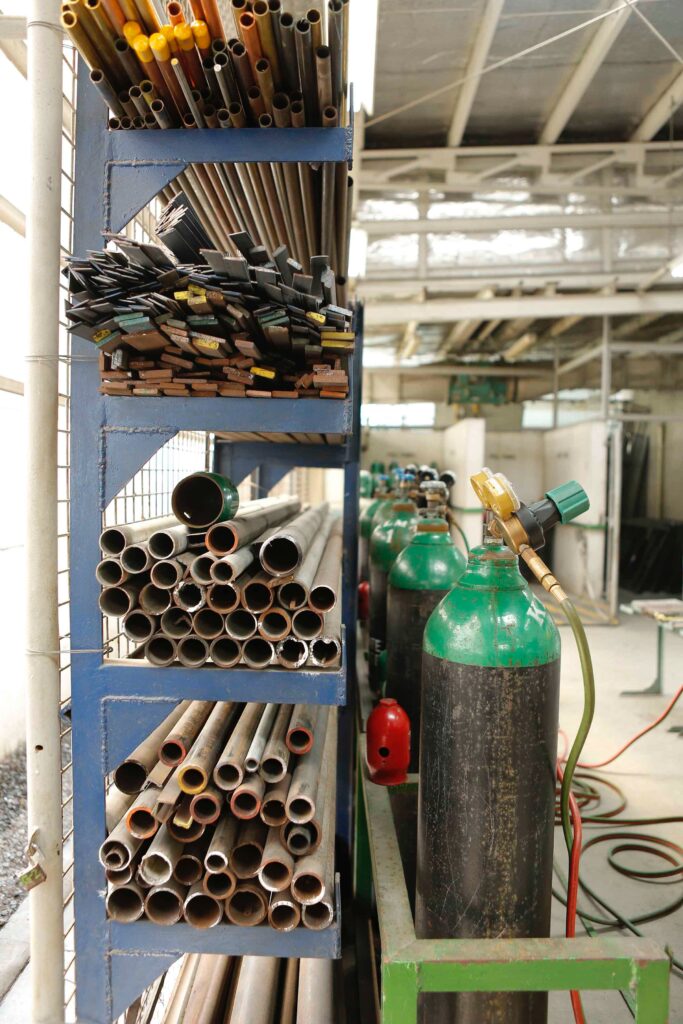Introduction
Liquefied Petroleum Gas (LPG) cylinders are essential for the safe storage and transportation of this versatile fuel. Over the years, various materials have been utilized for manufacturing LPG cylinders, each offering distinct advantages and disadvantages. In this blog, you will find out about the materials used in LPG cylinder construction, discuss their pros and cons, examine historical examples of LPG cylinder usage, and explore future trends in LPG cylinder materials.
Various Types of Cylinders

1) Steel Cylinders: Steel has been a prominent choice for LPG cylinder manufacturing for a long time. These cylinders are known for their strength and durability, allowing them to withstand high pressure and rough handling. Steel cylinders provide excellent protection against external impacts and are resistant to fire hazards. They also have a long service life and require minimal maintenance. However, steel cylinders are relatively heavy, making transportation and handling more challenging. Rust formation can also be an issue, necessitating regular inspections and maintenance.
Historical Facts: In the mid-20th century, welded steel cylinders were widely used, offering robustness and reliability for LPG storage and usage.

2) Aluminum Cylinders: Aluminum cylinders gained popularity due to their lightweight nature, making them easier to handle and transport. They offer corrosion resistance and do not rust, eliminating the need for frequent maintenance. Aluminum cylinders have better heat conductivity, allowing for faster heating and cooling of the contained LPG. However, they tend to be more expensive than steel cylinders and may require specialized welding techniques. Aluminum has a lower tensile strength(Aluminium 6061 which is the most used alloy in gas cylinders has a tensile strength of 210 MPa) than steel( Steel has a tensile strength of 621 MPa), making the cylinders more susceptible to deformation under impact.
Historical Facts: In the late 1960s and early 1970s, aluminum cylinders were introduced as a lighter alternative, providing convenience and mobility for domestic and camping applications.

3) Composite Cylinders: Composite materials, such as fiberglass-reinforced plastic (FRP) and carbon fiber-reinforced composites, have emerged as innovative alternatives for LPG cylinder construction. These materials offer exceptional strength-to-weight ratios, resulting in lightweight cylinders that are easy to handle and transport. Composite cylinders are corrosion-resistant, eliminating concerns about rust formation. They also exhibit superior impact resistance compared to steel or aluminum cylinders. However, composite cylinders can be relatively expensive, and specialized manufacturing processes are required as well as highly skilled workers.
Historical Facts: In the early 2000s, composite LPG cylinders gained traction as an alternative to traditional materials. They were initially used in niche applications, such as boating and caravanning, offering lightweight and corrosion-resistant solutions.
Future Trend
As the world moves towards a greener and more sustainable future, the LPG industry is also witnessing exciting developments in cylinder materials. LPG cylinders play a crucial role in storage and transportation, and advancements in materials offer opportunities to enhance safety, efficiency, and environmental impact.

1) Lightweight and Advanced Composites: One of the key trends in future LPG cylinder materials is the use of lightweight and advanced composites. Lightweight cylinders have several advantages, including ease of handling, reduced transportation costs, and improved user convenience over the more used gas cylinders like steel or aluminium. Additionally, advanced composites can be engineered to have high impact resistance, ensuring safety during handling and transportation.

2) Hybrid Materials: Hybrid materials, combining the benefits of different materials, are gaining attention in the development of future LPG cylinders. By strategically incorporating multiple composites with similar types of structure at the nanometer and the molecular level to create cylinders with optimized properties. The hybrid material-made cylinder will have much more balanced strength, less vulnerabilities, less cost to manufacture, improved tensile strength, etc. All in all hybrid materials will dominate the world in the future as the labor and technology becomes more and more advanced driving down the cost of setting up such an operation.

3) Smart Technologies and Sensors: The integration of smart technologies and sensors in LPG cylinders is another promising trend for the future. Sensors can provide real-time monitoring of critical parameters like pressure, temperature, and leakage, ensuring enhanced safety and prompt detection of any anomalies. By equipping cylinders with IoT (Internet of Things) capabilities, users can remotely monitor the status of their cylinders, receive alerts, and optimize refill schedules. Smart technologies also enable efficient cylinder management, reducing the risk of gas shortages and ensuring timely replacements or refills.

4) Sustainable Materials and Manufacturing: The future of LPG cylinder materials is closely aligned with sustainability goals. The industry is exploring materials and manufacturing processes that reduce environmental impact and promote circularity. For instance, using recycled composites or bio-based resins can help minimize the consumption of virgin resources. Additionally, eco-friendly coatings or surface treatments can provide corrosion resistance while minimizing the release of harmful substances. Sustainable manufacturing practices, such as energy-efficient processes or waste reduction strategies, are also being adopted to ensure the overall environmental sustainability of LPG cylinders.

5) Improved Safety Standards: Advancements in LPG cylinder materials are closely linked to improving safety standards. Future materials undergo rigorous testing and certification processes to ensure compliance with international safety regulations. Enhanced impact resistance, corrosion resistance, and fire resistance properties are key considerations in the development of new materials. Furthermore, materials with superior leak prevention capabilities contribute to the overall safety of LPG cylinders, reducing the risk of accidents or gas leaks.

6) Environmental Benefits: The future trends in LPG cylinder materials align with the broader environmental goals of reducing carbon emissions and promoting sustainability as laid down by the extremely important Paris Agreement in 2015. Lightweight materials translate to lower transportation-related emissions and improved fuel efficiency. Additionally, sustainable materials and manufacturing processes reduce the ecological footprint of the LPG cylinder industry. By adopting these advancements, the industry can contribute to a greener and more sustainable energy landscape.
Conclusion
LPG cylinder materials have evolved over time, aiming to enhance safety, convenience, and efficiency. Steel, aluminum, and composite materials have played significant roles in shaping the LPG cylinder industry. While steel cylinders offer robustness, aluminum cylinders provide lightweight mobility and composite cylinders offer higher strength while also being lighter than either. Looking ahead, future trends point towards the use of advanced composites, hybrid materials, and smart and sustainable solutions for LPG cylinders, ensuring improved safety, efficiency, and environmental impact in the years to come.



